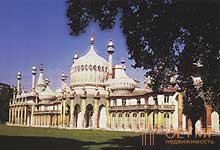
Eclecticism (from the Greek. Ekiektikos - capable of choosing, choosing) - a combination of diverse artistic elements; usually takes place during periods of decay of art.  Elements of eclecticism are noticeable, for example, in late ancient Roman art, combining forms borrowed from the art of Greece, Egypt, Western Asia and others. To eclecticism, representatives of the Bologna school, who believed that they could achieve perfection, combining the best, in their opinion, hand creativity great masters of the Renaissance.
Elements of eclecticism are noticeable, for example, in late ancient Roman art, combining forms borrowed from the art of Greece, Egypt, Western Asia and others. To eclecticism, representatives of the Bologna school, who believed that they could achieve perfection, combining the best, in their opinion, hand creativity great masters of the Renaissance.
In the history of art, eclecticism of the architecture of the mid-second half of the 19th century occupies the most prominent place. It is extremely widely and often uncritically used forms of various historical styles (Gothic, Renaissance, Baroque, Rococo, etc.); it is characteristic, however, that this architectural and design eclecticism with its “freedom of choice” of architectural and ornamental motifs had a significant influence on the development of a holistic in its essence, but fed from the most diverse sources of the “modern” style.
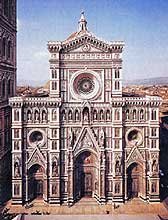 In the field of fine arts, eclecticism is most typical for salon art. From the middle of the 20th century, the eclectic tendencies were widely spread in Western European and American culture. in connection with the emergence of postmodernism and the fashion for the “retrospectiveism” of artistic design, copying certain stylistic directions of the past (including 19th-century eclecticism).
In the field of fine arts, eclecticism is most typical for salon art. From the middle of the 20th century, the eclectic tendencies were widely spread in Western European and American culture. in connection with the emergence of postmodernism and the fashion for the “retrospectiveism” of artistic design, copying certain stylistic directions of the past (including 19th-century eclecticism). 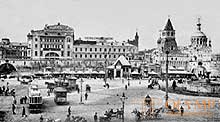
In the Moscow architecture of the second half of the XIX century. along with the “Russian-Byzantine style” in the largest state and church buildings and the “Russian style” in public buildings designed to express the revival of national culture in many buildings (including a completely new type, such as railway stations, banks, trade, office buildings, large apartment buildings) used elements of the “European”, so-called “historical”, styles (Neo-Renaissance, Neo-Baroque, Neorococo, Neo-Gothic). Despite the "multi-style", eclecticism to create large urban ensembles in the "Russian" or "European" styles (Red and Lubyanka Square, building China-town). 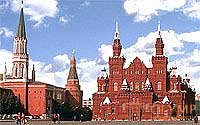 The modern look of the historical part of Moscow is largely shaped by eclecticism, the basic principles of which corresponded to the requirements of the enlarged scale of development.
The modern look of the historical part of Moscow is largely shaped by eclecticism, the basic principles of which corresponded to the requirements of the enlarged scale of development. 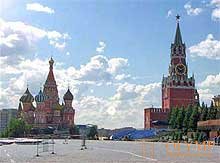 The “façade” architecture of eclectic, despite some fragmentation and monotonous repetition of details, gave the frontal surface of buildings greater relief and picturesqueness, it is actively used rustovka, forms of order decoration, ornate trim, finely designed decorative stucco, stucco sculpture, reliefs and statues, including the figures of the Atlanteans and the Caryatids; the appearance of bay windows introduced into the structure of the decor strong plastic accents.
The “façade” architecture of eclectic, despite some fragmentation and monotonous repetition of details, gave the frontal surface of buildings greater relief and picturesqueness, it is actively used rustovka, forms of order decoration, ornate trim, finely designed decorative stucco, stucco sculpture, reliefs and statues, including the figures of the Atlanteans and the Caryatids; the appearance of bay windows introduced into the structure of the decor strong plastic accents. 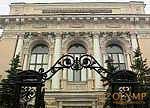 Much attention was paid to the urban development role of large buildings, the expressiveness of their silhouette, which ended in spectacular, visible domes or peaked surfaces with ridges from afar. A characteristic feature of the building of Moscow in the 1870-90s. there was the emergence of monumental, representative, often overloaded with decor, sometimes quaint and elaborate in its forms of buildings, nevertheless quite organically “included” in the structure of the city (State Bank on Neglinnaya Street, architect KM Bykovsky, 1893–95; International Trade Bank at Kuznetsky Most, architect S. Eybushits, 1898; Sandunovsky baths, architect B.V. Freidenberg, 1894-95). For public buildings and eclectic mansions, interior decoration in various “historical styles” (classicizing, neo-Gothic, Moorish, etc.) is typical.
Much attention was paid to the urban development role of large buildings, the expressiveness of their silhouette, which ended in spectacular, visible domes or peaked surfaces with ridges from afar. A characteristic feature of the building of Moscow in the 1870-90s. there was the emergence of monumental, representative, often overloaded with decor, sometimes quaint and elaborate in its forms of buildings, nevertheless quite organically “included” in the structure of the city (State Bank on Neglinnaya Street, architect KM Bykovsky, 1893–95; International Trade Bank at Kuznetsky Most, architect S. Eybushits, 1898; Sandunovsky baths, architect B.V. Freidenberg, 1894-95). For public buildings and eclectic mansions, interior decoration in various “historical styles” (classicizing, neo-Gothic, Moorish, etc.) is typical.
Что бы оставить комментарий войдите
Комментарии (0)